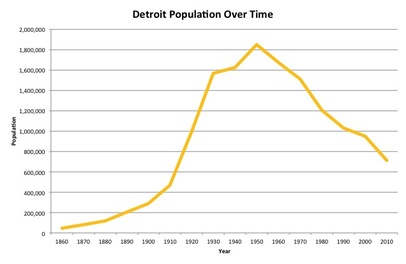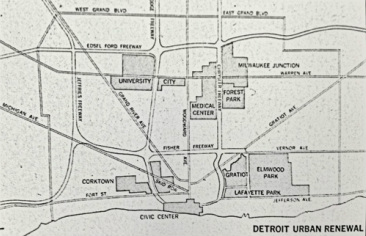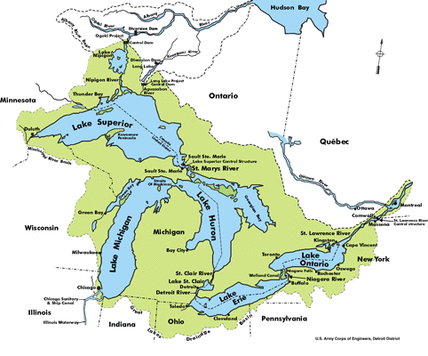Population Changes
Overall Changes

Detroit Population From 1860-2010
Since Detroit's rise in the early 1900s, Detroit has experienced seriously population decrease. At its height in 1950 Detroit commanded a population just over 1.8 million. By 2010 that number had decreased to 713,777 - a decline of almost 60% in as many years.
The decline of Detroit's population follows remarkably closely the trajectory of the automobile industry, which also hit its peak in the 1950s. Shortly after, due to unionization of labor, foreign competition, and other factors, companies began to merge or go out of business as profit margins narrowed. The auto industry, like Detroit's population, has been in decline ever since.
The history of Detroit's population does not truly begin until the 1820s with the help of Governor Lewis Cass, the Erie Canal, and the Steam Engine.
The decline of Detroit's population follows remarkably closely the trajectory of the automobile industry, which also hit its peak in the 1950s. Shortly after, due to unionization of labor, foreign competition, and other factors, companies began to merge or go out of business as profit margins narrowed. The auto industry, like Detroit's population, has been in decline ever since.
The history of Detroit's population does not truly begin until the 1820s with the help of Governor Lewis Cass, the Erie Canal, and the Steam Engine.
Lewis Cass - Land Negotiations and the Campaign for Residents (1820s)
|
In the 1820s Governor Lewis Cass gained the nickname "Big Belly" from the American Indians living in the area, and through a series of negotiations convinced the Indians to cede the land that is most of Michigan today. (Woodford 2001, 49)
At the same time, Cass began a campaign to increase the population of Detroit (which had previously been looked over as settlers migrated west). He wrote to politicians and wrote articles trying to improve the reputation of Detroit and appeal to westward moving migrants. As part of this, Cass began to sell large parcels of public land to individuals to entice settlement at low costs (Woodford 2001, 50-51). The large lots helped to create the spatial pattern of greenery and single-family detached homes that still characterizes the city (this may have even begun with Woodward who required minimum lot sizes of 5,000sq. ft. in his infamous plan) (Ibid 39). Rowhouses were not built in the early days of the city, and in the 1940s-50s two-thirds of the structures were detached single-family homes, and another one-fifth were two-family homes. (Sugrue 2004) |
Waves of Immigration 1830s-1930s

Coupled with the Industrial Revolution, this movement helped to bring in the massive wave of immigration that followed. The Germans came in the 1830s, to escape political problems, and the Irish came in the 1840s to escape the potato famine. Interestingly, the Poles were recruited, (in the 1870s) in order to fill gaps in labor supply (Bedard 2009, 25). These immigrants settled both close to their jobs in factories and to one another, developing ethnically-based communities and neighborhoods. The Germans settled along Gratiot Road on the east, the Irish Corktown in the lower west, and the Poles located centrally in Poletown (south of Hamtramck). (Ibid, 26)
Two cities are surrounded by Detroit - the City of Highland Park and the City of Hamtramck. Hamtramck is historically Polish, and was formed in 1922 by a community that wanted to maintain its cultural identity and truly feel a sense of freedom vastly different from their homeland (Kowalski 2002, 7). Highland Park developed just a few years prior, and focused around a factory for its economy.
By 1900 over 75% of the population was foreign born, had one parent that was foreign born or was African American (which, prior to WWI immigration in 1910 was a small portion of the population) (Zunz 1978, 4-5).
Also of note are the two neighborhoods Black Bottom and Paradise Valley, which were founded during 1910-1930. These historic neighborhoods were home to black communities prominent in Detroit's music and cultural scene. Motown grew up in these neighborhoods, and they were alive with jazz. These two areas would be among those hardest hit during the country's urban renewal attempt, with Black Bottom being demolished for a highway and a park.
Two cities are surrounded by Detroit - the City of Highland Park and the City of Hamtramck. Hamtramck is historically Polish, and was formed in 1922 by a community that wanted to maintain its cultural identity and truly feel a sense of freedom vastly different from their homeland (Kowalski 2002, 7). Highland Park developed just a few years prior, and focused around a factory for its economy.
By 1900 over 75% of the population was foreign born, had one parent that was foreign born or was African American (which, prior to WWI immigration in 1910 was a small portion of the population) (Zunz 1978, 4-5).
Also of note are the two neighborhoods Black Bottom and Paradise Valley, which were founded during 1910-1930. These historic neighborhoods were home to black communities prominent in Detroit's music and cultural scene. Motown grew up in these neighborhoods, and they were alive with jazz. These two areas would be among those hardest hit during the country's urban renewal attempt, with Black Bottom being demolished for a highway and a park.
World War I (mid 1910s)
During WWI, immigration policies restricted foreign-born immigration. This came at a time when labor was still very much needed, as many Detroit factories switched to producing military equipment. It was around this time that Ford especially began hiring many African-American workers. (Sugrue 2004) and the African-American population shot up. This can be seen in population breakdowns: in the 1910 census there were 5,741 African-Americans, in 1920 there 40,838, and in the 1930 census a whopping 120,066 African-Americans lived in Detroit. This means the black population increased by a factor of almost twenty-four in a twenty-year period. WWI serves as another example for the notion that Detroit essentially "put all of its eggs in one basket" - when manufacturing was on the rise, Detroit was booming, and when it was low, Detroit sunk lower than other cities. WWI was one time when Detroit was riding high.
Urban Renewal Destruction (1960s)

Areas Targeted for Urban Renewal - Detroit
When urban renewal was a big trend in the 1960s, many Detroit neighborhoods were decimated (as they were in many cities). Though the areas chosen for renewal were picked on the basis of housing, they also represented some of the most vibrant, working class communities (Woodford 2001, 169). This includes mostly the ethnic neighborhoods described above: Corktown, Poletown, Black Bottom, Paradise Valley, and others. While some 1,500 acres were cleared for renewal, the bureaucratic nature of urban renewal meant it was a long time before any building occurred, and due to the unpopular nature of the urban renewal programs, not all of it was seen through to fruition (Ibird 170). Thus it can be speculated that the vacant land phenomenon began in the 1960s and has only gotten worse since.

